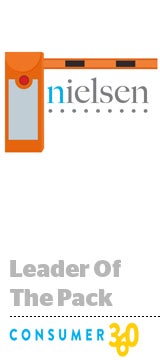 Nielsen has a new program designed to give advertisers and agencies a clearer lens into the digital audience activation process, the company announced Wednesday at its Consumer 360 conference in Washington, DC.
Nielsen has a new program designed to give advertisers and agencies a clearer lens into the digital audience activation process, the company announced Wednesday at its Consumer 360 conference in Washington, DC.
The inaugural set of “Preferred Platform Partners” includes BrightRoll, DoubleClick, FreeWheel, Moat, RocketFuel, TubeMogul, Tremor Video, Viant and Videology. Other ad tech platforms can apply, but must meet certain requirements for tagging, reporting and server connections.
All nine partners will provide Nielsen Digital Ad Ratings (formerly known as Online Campaign Ratings) for campaign measurement and reporting using Nielsen’s panel-based demo data and next-day desktop and mobile audience reports.
Over time, Nielsen will factor in more measurement allowances for platform members, including eXelate audience segments and Nielsen Digital Brand Effect.
“We find that it’s more and more important to make sure our data is ubiquitous through the systems that do the ad decisioning or that help do the decisioning,” said Andrew Feigenson, managing director of digital at Nielsen.
“We certainly know who’s done what type of integration with us, so this is a more formal way for us to tell advertisers and agencies – the people who use these platforms – this is how Nielsen’s data is being used,” he said.
Moat is the only ad-quality verification vendor that made the initial cut, but that doesn’t preclude competitors from becoming preferred platform partners. Moat works with Nielsen on viewability, but also analyzes ways to improve on-target rates for advertisers and publishers, Feigenson said.
In addition to the Preferred Platform Partner program, Nielsen plans to enable total audience measurement beyond ads to include programs and content by the end of this year.
There are a lot of moving parts, but Steve Hasker, Nielsen’s global president, seemed confident about the progress the company has made so far.
Nielsen’s deal to bake Digital Ad Ratings into Roku’s operating system and its work with Adobe to develop Digital Content Ratings last September were both big milestones in Nielsen’s cross-platform measurement push.
“There were three or four pieces, including mobile campaign ratings, that needed to come together in order to produce total audience by the end of this year,” said Hasker. “Once that data starts to flow, the next question is how will this affect C3 and C7 ratings, because those need to be expanded and updated.”
Advertisers want to gauge audience viewership outside of the standard window of time required for an ad load to carry through and get credit, the basis of C3 and C7 ratings.
There is also the question of whether the predominant TV rating would be applicable to pure-play online video providers, in addition to streaming or VOD platforms.
“The industry will need to gather major buyers [and] sellers [and] wrestle with those rules together,” Hasker said, adding that Nielsen “will not and cannot make every single call around the definition of those metrics.”










